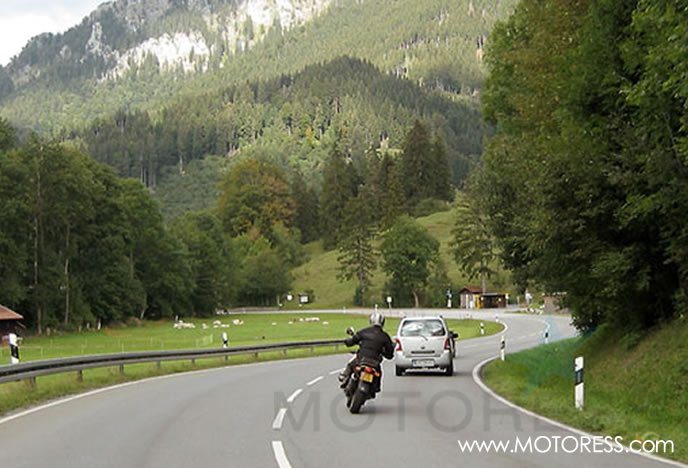Last Update: 28 October 2021

As a motorcyclist you’ll encounter situations (collision avoidance; obstacle avoidance) while riding along which allow you but a split second to decide what to do. And what you decide has to have a successful result. You’ll need to make and implement the right solution for that moment. Will you brake? Accelerate? Swerve? And if so to which direction? And when reviewing your actions to the situation afterwards, you’ll often arrive at the conclusion that your chosen option was not exactly the best. That’s because after the fact you have the time, the calm and clarity of thought to review these options – to weigh out the pros and cons. The result will be an informed decision.
Can you prepare for these split second decisions before they happen? Never completely. But, in many cases, yes! Even when you’ve little time to react. And did you know, that riders are generally not well practised in this form of “fast thinking” – the result is usually ends up being “non-reactive” meaning, nothing is done.
Your response is guided by your “PR’s” – panic reflexes where often you tense up, become rigid, wide-eyed, freeze up and pray for a good outcome. Well, in our situations, our decisions are literally, life and death.
So, yes, we need to do things differently in preparation for danger and one very important method is – brain training! The mental practise of “outs” or proper manoeuvre sequences in your mind before they happen can help ensure the right action when having to operate in “panic mode”. Think about a hypothetical situation and then figure out, picture in your mind, and visualise the best solution. This sets the reaction in your brain in motion to create an auto-response in the case of such a future occurrence.
As motorcyclists, we need to do things differently in preparation for danger and one very important method is – brain training! The mental practise of “outs” or proper manoeuvre sequences in your mind, before they happen, can help ensure the right action when having to operate in “panic mode”.~ Vicki Gray
You can create a number of dangerous but realistic situations which you may meet on your motorcycle. Be reasonable in this practice and focus on true realistic happenings.
Let’s Practise Using the Example of “Overtaking” or Passing A Vehicle.
Passing on a Two Lane Road
There are two big dangers which are a threat when you overtake and pass the vehicle in front of you:
- Suddenly an oncoming vehicle appears and is quickly coming at you as you use its lane to pass in.
- The vehicle you are overtaking suddenly moves to the left (where you are) or even worse, turns to the left.
In the first case (oncoming) there are two possible solutions.
- Brake and return back behind the vehicle that you wanted to pass or
- Accelerate ensuring you pass the vehicle and return to your lane before meeting with the oncoming vehicle.
Which of the two you choose will depend on where you’re positioned at the moment you see the oncoming vehicle; how much time/space/speed you need to get back into your lane and how close you are to the oncoming traffic.
You can practice this situation under normal passing occurrences when riding. Think about which place would you have time to brake, and at which point, braking may be too late a choice; and at what point in your passing manoeuvre would you accelerate.
Even more importantly in this mindful training, you need to ensure the risk in this situation is reduced or prevented. It’s about mindfully observance at the scene in the distance, watching the road in front of you and taking account of oncoming traffic that hidden.
Dead Ground
Especially hilly regions or mountain regions, one physical hazard that’s not easy to spot is something known as “Dead Ground”. This is where the road dips into a hollow giving you the illusion that there are no oncoming vehicles when in fact, there are. Vehicles in this dip cannot be seen so care must be taken before overtaking to ensure there are no areas of dead ground hiding the oncoming traffic.
Passing, Step by Step
To reduce your chances and select the right solution when overtaking, the following should always be practised:
- See if the road beyond the vehicle you’re overtaking has enough space ahead of it, once you’ve overtaken it.
- Don’t ride too close behind the vehicle you’ll overtake; but at least 25 feet away. The distance depends strongly on the speed you’re already moving. The higher the speed = the more distance required.
- Shift down a gear – to where your motorcycle has the most available peak power and delivers the most torque and speed. This gives you the fastest acceleration response.
- Look in your mirrors, check the space behind you to ensure there’s not a vehicle trying to overtake you or already coming up quickly from behind in the lane you’re moving to.
- Turn your left indicator signal on, accelerate “give gas” smoothly (not too slow) and in an even motion move to the left side of the lane as you continue to accelerate.
- Position yourself not too close but with room enough to the vehicle you’re passing
- Normally you will up shift to the next gear as you’re passing the vehicle.
- Once you have passed the car, turn on your right signal indicator and move back to your lane and the proper lane position.
If you’re rehearsed on these steps and practice the same routine as above when passing, then you’ll reduce your chances in a dangerous situations of performing them incorrectly.
As a motorcyclist you will observe many riders who’ll take their time to overtake, and don’t down shift during the overtake. These riders ride far too relaxed and if ever an oncoming vehicle unexpectedly pops up, they won’t be prepared to respond. And if they do it will be significantly delayed because as in number two above “accelerate” won’t be quick enough – as first you must down shift.
What you do in each hazardous situation is very much depending on your personal situation, driving experience and control of your motorcycle. If you have off-the-road experience then solutions such as opting to use the shoulder of a road as a safe out – or the grass area, may work well for you.
When you begin to think and imagine options in your hazardous situations, you’ll discover there are quite a few (that’s why it’s often so difficult to choose).
Once you’ve determined the best solution for a given situation, you then save it to your memory; a form of neuro-linguistic programming.
Simply put, you call on your memory to: provide the solution for the particular situation you already have pre-defined. It could even be when in this particular situation, the solution (or solutions, because usually there is more than one) will be initiated timely without much thought. But it’s a lot easier to choose between two or three solutions. It’s these which you’ve thought out at length versus encountering that split second scenario where then you start thinking about possibilities, and then make a choice. The time needed to review possibilities – is time you simply don’t have.
To program the options strongly in your memory you need to rehearse regularly, over and over in your mind- the solutions you have chosen. The result will then be, that if ever you do encounter these situations – you will almost automatically choose the best solution.
Don’t wait until dangers happen to start thinking about solutions; look ahead and review solutions for problems that you hope you’ll never suffer from.
MOTORESS director, Vicki Gray is a basic, advanced road and race motorcycle instructor – certified for over 30 years. She is a motorcycle licensing examiner and has instructed, examined and licensed riders for European and North American road racing schools.




